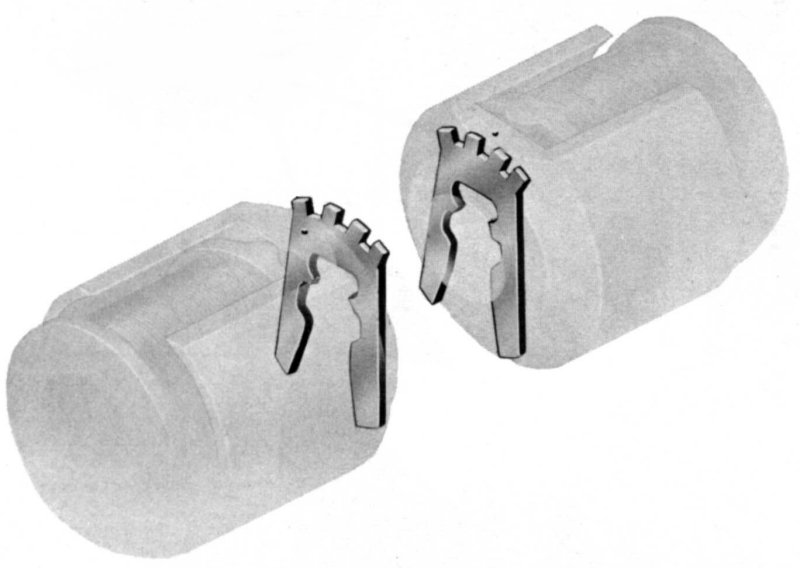
Accutrons differ considerably from mechanical watches in their need for service. It is recommended that a mechanical watch be serviced every 3-5 years in order for it to retain its timekeeping ability and to ensure maximum life expectancy. Mechanical watches are greatly dependant on the quality of the lubricating oil in them to minimize friction and ensure consistent functioning of the escapement. Even the best oil deteriorates with time, and slowly works its way out of the bearings in the watch where it is most needed. A high-grade mechanical watch, if serviced regularly and used correctly, should last several hundred years.
The accuracy of Accutrons is not governed by the quality of the oil in their bearings or pivots to the same extent as mechanical watches. However, minimizing friction in an Accutron is still very important, and not surprisingly, old and gummy oil will cause problems. The forces acting on the gear train of an Accutron are far less than a spring-driven mechanical watch. Even so, they are equally susceptible to dirt, and can be stopped or have their timekeeping affected seriously by even small amounts of foreign matter, just like any other watch. Every time a battery is replaced, a small amount of dirt enters the watch. Often , the case and crown seals may have deteriorated, and over a period of years, dirt will find its way into the watch. Hence it is recommended that an Accutron should be serviced at least every 5-10 years, even if it is working perfectly. A properly maintained Accutron should last as long as a high-quality mechanical watch.
Bulova guaranteed their Accutrons to keep time to 1 minute per month (or 99.9977% accurate, as their sales literature used to say!). There is no reason at all nearly 40 years later that this level of accuracy should not still be expected and be obtainable. So if your watch is not working to these limits, it is necessary to determine whether the watch needs servicing, or simply adjusting, before any action is taken. Regulation is achieved by adjusting small weights on the tuning fork, which have the effect of changing its natural frequency of vibration.
Even in these hi-tech times, selecting a suitable time source of known accuracy is not all that easy. We are so used to seeing digital time displays on everything that we take it for granted that they are correct. Even the clock in your computer may be fast or slow by a several seconds a day. We need to get down to at least 1 second a day or less to check our Accutrons, or we are just wasting our time.
Clocks powered by the AC mains are only accurate over long period of time, and may vary quite an amount over a single day. Time sources over the internet may be out by many seconds, depending on internet traffic out the time. Many time services provided by phone companies are very accurate these days, even so, it is worth making enquiries with them to be certain. A high-quality quartz watch would be a reasonable alternative, as they have a very consistent rate. If you have access to a GPS receiver, then look no further, as the time signal provided by the GPS system is extremely accurate, around 340 nanoseconds per day.
There are many sites on the internet dealing with this issue, so there's no need for us to re-invent the wheel here. Check the site "Horology-the Index". This has the most comprehensive list of links on this subject you are likely to find anywhere.
Regulation of your Accutron
Well, you're ready to regulate your watch now:
The pic below shows the Accutron regulators, mounted on the cups of the tuning fork.

Note that the top edge of each regulator consists of 4 flats and 3 gaps. Next to each regulator is a little dimple or dot on the tuning fork cup. Moving a regulator by the distance of one flat or 1 gap relative to the dimple will make the watch gain or lose 2 seconds a day. That means, a total variation of 14 seconds per day for each tuning fork cup is possible. However, we avoid adjusting only 1 regulator. The amount of adjustment is "spread" between the two regulators, to keep the fork in balance. For example, if the rate is 4 seconds a day out, we adjust each regulator by 2 seconds.
Okay, Okay, let's get on with it. Moving the regulators away from the centre of the watch will make it go slower, and conversely, moving the regulators toward the centre of the watch will make it go faster. Great care must be taken not to touch the coils, also to apply absolute minimum force required to move the regulators without stressing the tuning fork. See pics below.
 |
 |
|---|---|
| Regulating Slower | Regulating Faster |
If you have access to a watch-timing machine, the job is perhaps a little easier, as the rate change can be monitored immediately, and over a period of a few hours, as it will settle down a bit. Bulova engineers determined that if the watch was adjusted to run two seconds a day slow in the dial-up position, it would be correct when worn by the average user. Checking of the rate is still best achieved in actual use by the wearer of the watch
Having completed the adjustment, replace the back gasket and close up the watch case. It is important that the correct serrated gasket be used for 214 model Accutrons, as proper operation of the back-setting crown is dependant on the correct thickness of the gasket. Over the next couple of days, monitor its performance during normal use. It may be necessary to make one more fine adjustment.